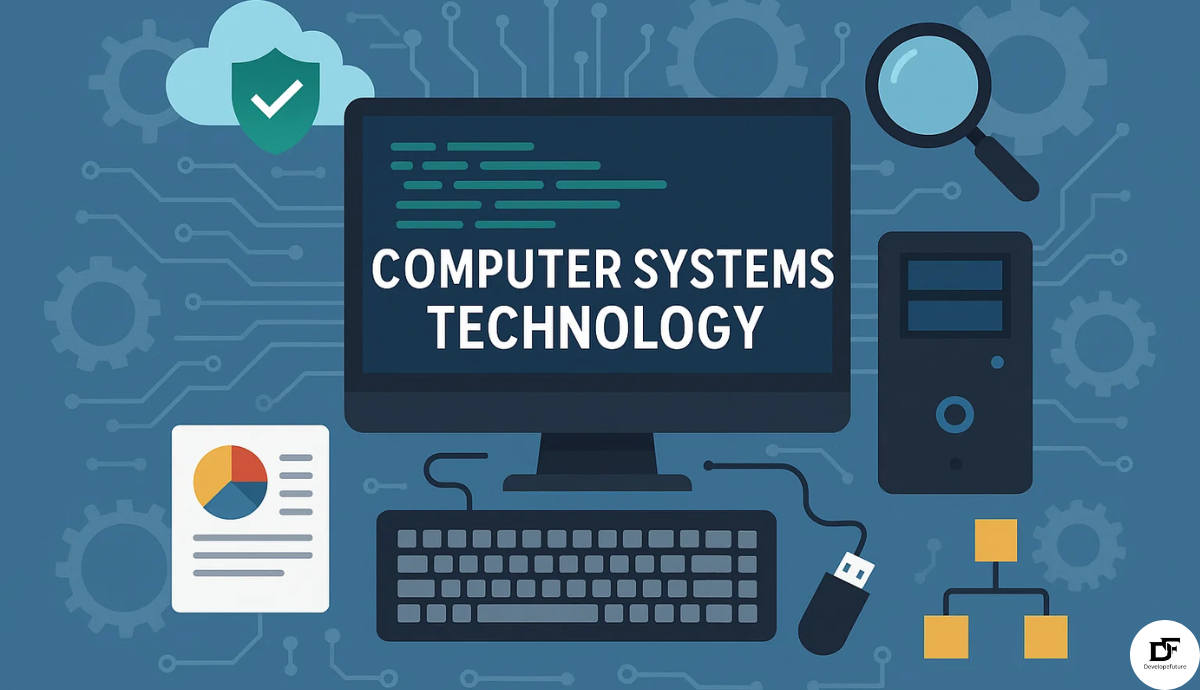Computer systems technology is a branch of applied science. That integrates computer hardware, software, and networking. And information systems to create effective digital solutions. It plays a vital role in modern industries. By ensuring that computers and networks operate efficiently. Whether in businesses, healthcare, education, or communication. Computer systems technology provides the backbone for smooth digital operations.
Understanding what computer systems technology is is essential in today’s digital era. It not only focuses on the technical aspects of computers. Additionally, in problem-solving, system management, and technological innovation. From configuring servers to managing data security. This field has become indispensable in shaping how we live, work. And it interacts with technology every day.
Table of Contents
Why Study Computer Systems Technology?
Studying computer systems technology offers students the chance to gain both theoretical knowledge and practical skills. This discipline equips individuals with the ability to understand. And manage computer networks, develop software solutions, and secure information systems. For anyone interested in technology. Studying this field provides the foundation to pursue diverse career paths across industries.
The demand for professionals skilled in computer systems technology continues to grow worldwide. As organizations rely heavily on digital systems. There is a consistent need for experts. Who can optimize performance, troubleshoot issues, and maintain security? Choosing to study this subject opens doors to rewarding careers in information technology. Also, system administration and software development.

Historical Development
The roots of Computer Systems Technology trace back to the evolution of computing itself. The modern digital computer emerged in the mid-20th century. With pioneers like Alan Turing conceptualizing programmable machines in the 1930s and 1940s. Early computers, such as the ENIAC (1945), were massive. Room-sized devices used for military calculations marked the beginning of hardware-focused system design.
The 1960s and 1970s saw the advent of integrated circuits. And microprocessors, enabling smaller, more affordable systems. This era birthed operating systems like UNIX (1969). Which laid the groundwork for modern networking and system management. The personal computer revolution in the 1980s. Spearheaded by companies like IBM and Apple, democratized computing. It is shifting focus from mainframes to microcomputers. And creating demand for technicians skilled in hardware assembly and software installation.
By the 1990s, the internet’s rise had integrated networking into CST Computer Systems Technology. With protocols like TCP/IP becoming essential. Educational programs in Computer Systems Technology CST) were formalized during this period. Responding to the growing need for professionals to maintain and expand corporate networks. Today, Computer Systems Technology has evolved to incorporate cloud computing, cybersecurity, and IoT. It reflects the field’s adaptability to technological advancements.

The Core Pillars of Computer Systems Technology
The field can be broken down into several fundamental pillars. Each representing a critical layer of a modern computing ecosystem.
1. Hardware Systems & Architecture This is the physical foundation. Computer Systems Technology professionals must understand the components. That makes up a computer and how it interacts.
- Components: CPUs (Central Processing Units), GPUs (Graphics Processing Units), RAM (Random Access Memory), storage devices (HDDs, SSDs), motherboards, and power supplies.
- Key Concepts: How processors execute instructions (the fetch-decode-execute cycle), memory hierarchy (caches, RAM, storage), and input/output systems. Understanding hardware is essential for troubleshooting, upgrading. And building systems tailored for specific tasks. Like gaming, data science, or web hosting.
2. Operating Systems (OS) The OS is the master software. That manages all hardware resources and provides common services for application software. CST delves into the practical administration of OSs.
- Key Functions: Process management, memory allocation, file systems, device drivers, and security.
- Practical Focus: Installation, configuration, and maintenance of Windows, Linux, macOS, and mobile OSs like Android and iOS. This includes scripting, automation, and performance tuning.
3. Networking & Telecommunications No computer is an island. Networking is the art and science of connecting computers to share resources and information.
- Core Concepts: TCP/IP model, routing and switching, Wi-Fi standards, network topologies, and protocols like DHCP and DNS.
- Practical Applications: Designing local area networks (LANs), configuring routers and firewalls, setting up virtual private networks (VPNs). And understanding wide area networks (WANs) and the internet itself. This pillar is the backbone of global connectivity.
4. Software & Application Support While not always about writing complex software from scratch, CST involves deploying, managing, and supporting software applications.
- Key Areas: Web servers (Apache, Nginx), database management systems (MySQL, PostgreSQL, MongoDB), and enterprise software. It involves ensuring applications have the resources they need to run smoothly. And are accessible to the right users.
5. Cybersecurity In an era of increasing digital threats. Security is not an add-on but a fundamental requirement woven into every aspect of CST.
- Key Practices: Implementing firewalls, intrusion detection/prevention systems (IDS/IPS), conducting vulnerability assessments, managing encryption, developing security policies, and incident response. A CST professional is often the first line of defense against cyberattacks.
6. Cloud Computing & Virtualization This is one of the most transformative trends in Computer Systems Technology. Instead of managing physical servers. Resources are provided as scalable, on-demand services over the internet.
- Virtualization: The technology that allows many “virtual” machines (VMs) to run on a single physical server. It drastically improving hardware use.
- Cloud Models: Understanding Infrastructure as a Service (IaaS), Platform as a Service (PaaS), and Software as a Service (SaaS). Skill with platforms like AWS and Microsoft Azure. Also Google Cloud Platform is now a highly sought-after skill.

Applications: Where is Computer Systems Technology Used?
Computer systems technology is applied in nearly every sector. It is making one of the most versatile fields. In healthcare, it supports patient record management, telemedicine, and advanced medical imaging systems. In the business world, it underpins enterprise software, customer databases, and e-commerce platforms. Each application demonstrates how computer systems technology supports efficiency and innovation.
Education also benefits significantly. With online learning platforms and smart classrooms relying on robust computer systems. Government, transportation, and manufacturing are other areas where the technology ensures smooth operations. From automated factories to secure banking. Computer systems technology forms the invisible infrastructure of modern society.
Education and Career Pathways
Educational programs in CST are typically offered at community colleges, technical institutes, and universities. Associate of Applied Science (AAS) degrees. Like those at Monroe Community College, provide foundational skills in two years. It is covering topics from hardware fundamentals to advanced networking. Bachelor’s programs, such as the BTech at City Tech. It delve deeper into system analysis and project management. Online options, like Rowan University’s BA in CST, cater to working professionals.
Certifications enhance employability, including CompTIA A+ for hardware, Network+ for networking. And Cisco CCNA for advanced routing.
Career opportunities are abundant and growing. Roles include:
- Computer Technician: Assembling and repairing systems (median salary around $59,000 USD, per BLS data).
- Network Administrator: Managing LAN/WAN setups.
- Systems Analyst: Designing and implementing technology solutions.
- IT Support Specialist: Providing helpdesk services.
The U.S. Bureau of Labor Statistics projects IT occupations to grow 15% from 2024 to 2034. It is much faster than average, driven by cybersecurity needs and cloud adoption. Continuous learning is key, as professionals must adapt to evolving technologies.

The Future of Computer Systems Technology
The future of computer systems technology looks promising. Its driven by innovation in artificial intelligence and machine learning. And also the Internet of Things (IoT). These advancements are reshaping how systems are built, maintained, and optimized. Cloud computing and edge computing are also redefining. How businesses deploy resources, offering flexibility and scalability.
Cybersecurity will remain a critical focus as threats become more complex and widespread. Professionals in computer systems technology will play an essential role in safeguarding data. And its ensuring system reliability. As industries continue their digital transformation. The future will demand experts. Who can integrate emerging technologies seamlessly into computer systems.
What Computer Systems Technology Grads Can Do?
Graduates of computer systems technology programs have versatile skills. That can be applied across industries. They can design and maintain computer networks. It troubleshoot software issues, and ensure system security. Their expertise is vital in roles. Such as IT support, system architecture, and database administration.
Beyond technical roles, grads can also pursue careers in project management, consulting, and training. Many choose to work in multinational corporations, government institutions, or entrepreneurial ventures. The adaptability of computer systems technology skills ensures. That graduates can thrive in a rapidly evolving digital landscape.
FAQ’s
What is computer systems technology in simple terms?
It is the study and application of computer hardware, software, networks, and systems. To ensure efficient operations across industries.
Is computer systems technology the same as computer science?
No, computer science focuses more on theoretical foundations and programming. Computer systems technology emphasizes practical system management and applications.
What jobs can I get with a degree in computer systems technology?
You can work as a system administrator, IT specialist, network engineer, database manager, or cybersecurity analyst.
Is computer systems technology a good career choice?
Yes, it offers diverse opportunities, high demand, and the potential for career growth in nearly every industry.
How is computer systems technology evolving in the future?
It is evolving through innovations in AI, cloud computing, IoT, and cybersecurity. It is becoming more integrated into daily life and global industries.
Conclusion
Computer systems technology has emerged as one of the most critical fields in the digital age. It encompasses the study and application of hardware, software and networking. System management to keep modern industries functioning efficiently. Its versatility ensures its presence in nearly every sector. From healthcare to education and business.
The importance of computer systems technology will only grow as new innovations emerge. Students who pursue this field gain valuable skills and career flexibility. While industries enjoy reliable system performance. In essence, computer systems technology is not about computers. It is about shaping the future of technology-driven society.

